Authors:
Anton Poikolainen Rosén, Vasanth Madhav Kamath, Gopinaath Kannabiran
In this dialogue about, through, and with soil, we use soil samples from Sweden and India to discuss the mutual interdependence of soil health and just sustainability transitions from a feminist perspective. We describe how we have come to know our soil and what role information technologies play in this process. We also reflect on how the livelihood of people living in vulnerable conditions and extreme climates can be improved with soil-centered technology. In our dialogue, we approach soil as existential, political, physical, chemical, biological, archaeological, and transformative. This is reflected in how people depend on healthy soils for sustenance, and how soils connect us to the cycles of life by bringing close to us processes of decay and nurturing. We also initiate discussions about soil in relation to the geopolitics of climate change and the role of designing technology with respect to various aspects of ecological responsibility.
→ Improving soil health and exploring alternative ways of sustainably growing food are major priorities for achieving food security.
→ Local farming communities need access to the expertise of biochemists for DIY biochemical testing of soil.
→ We need to design climate-smart agricultural technologies that are attendant to the gendered geopolitics of climate change and an emplaced ethics of care.
I have selected a soil sample taken from the lawn of an urban farm in Tantolunden in Stockholm, Sweden. The soil was compact, muddy, and pale, which indicates that growing conditions for food crops are not optimal. Figure 1 depicts the sample in its soil form and Figure 2 depicts it as a chromatogram developed in a chemical test.
 | Figure 1: A soil sample from a lawn in Tantolunden in Stockholm, Sweden. |
 | Figure 2: Chromatogram of a soil sample from a lawn in Tantolunden in Stockholm, Sweden. |
Why this soil sample is significant to me. This sample symbolizes the power of collective action in transitions toward sustainable societies. Five years ago, there was a biodiversity desert (lawn) in the space where the sample is from (Figure 3). Today permaculture cultivations thrive in the space, providing food and leisure for humans and a habitat for insects and urban critters (Figure 4). The soil of these cultivations has been built slowly over the years, by leaves and branches brought by park workers, collectively sourced bokashi compost, and soil donations from gardening companies.
 | Figure 3: The lawn before the urban farm was founded. |
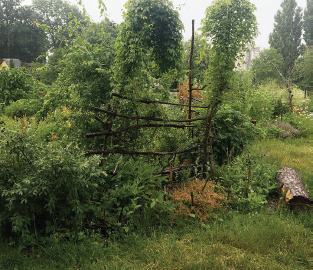 | Figure 4: The same lawn after five years of permaculture cultivation. |
The sample also represents something more troubling: the risk of pollution. There have been many operations in the urban space over the centuries and they have left their archaeological traces. When digging in this soil, we find shards of glass from beer bottles drunk decades ago and plastic from more recent picnics. What you don't see with the naked eye, however, is the lead left from industries and cars.
How I got information about the soil. The urban farmers sent in a soil sample for laboratory testing to make sure that they could grow crops in the space. The top layers, in which plants are grown and from which my sample is taken, do not contain significant traces of lead. However, the deeper layers of the soil contain lead in unhealthy concentrations.
The urban farmers wanted to monitor their soil health over time. Sending soil samples to a laboratory, however, is expensive and time-consuming. Instead, the urban farmers made a qualitative assessment of the soil health through the chemical test methods of chromatography (as reported in more detail in [1]). By dissolving soil and letting it soak into a piece of paper through a cotton thread, different components of the solution are separated by weight. The paper is prepared with silver nitrate, which reacts with the separated components when exposed to light, making them more visually distinct. This is similar to the development of analog photos—why the result is often framed as a "soil portrait." By analyzing the patterns that appear on the paper, the composition of compounds in the soil can be interpreted and its health judged.
Figure 5 depicts a chromatogram of bokashi compost rich in nutrients. By contrast, the dull and blended colors of the chromatogram depicted in Figure 2 indicate that there is little nutrition in the soil. The sample also has a darker circle of color that represents a specific compound. Some urban farmers worried that it might be lead. However, they did not have the skills to interpret this circle. This points to a need to bridge communities of DIY biochemical testing with biochemists. The interpretation of DIY chemical tests could be supported, for example, through online consulting services or the training of image-recognition algorithms to interpret images of chromatograms.
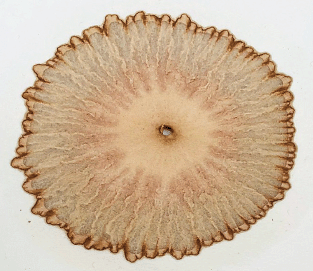 | Figure 5: A chromatogram of bokashi compost. |
I have selected a soil sample from Bajju Tejpura, a village in Bikaner district in Rajasthan, India, which is a desert region. The soil in this region is alkaline and sandy (Figure 6); nutrients required for farming are absent, and the soil's ability to hold nutrients is very low. It is prone to losing water and nutrients from the top layer, owing to soil structure and high temperatures in the region. This soil sample represents one example scenario among many that are relevant to the goals of HydroGreens vertical farming—primarily, growing fresh fodder and nursery in arid and semi-arid regions using low-cost, microclimate-controlled grow houses.
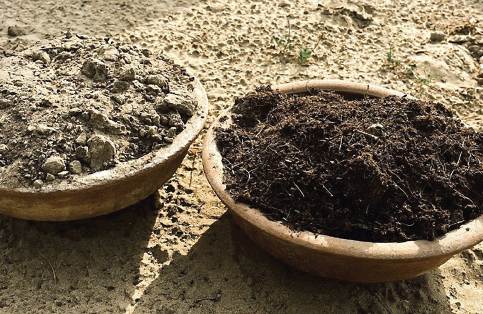 | Figure 6: Sample of soil from a desert region in India (left) and cocopeat with compost mixture (right). |
Why this soil sample is significant to me. To understand the significance of these soil samples in my work, I would like to provide some background context relevant to the HydroGreens project. India is a major force in the worldwide agriculture sector but also a country that faces severe climate change-related disasters. Climate change must be understood geopolitically; India ranked seventh in the Global Climate Risk Index of the 10 most-affected countries in 2019. The largest source of livelihood in India is from agriculture and associated sectors. Climate change-related impacts on agriculture in India have enormous effects on both the country and the global food chain. In this context, climate-smart agriculture (CSA) initiatives prioritize food security by innovatively adapting to the effects of climate change. There are several CSA projects involving the management of scarce natural resources, efficient soil nutrition, sustainable farming, biodiversity health of local ecosystems, and ethical livestock husbandry. HyrdroGreens is one such CSA project that aims to support small-scale farmers in water-scarce regions in India.
Our HydroGreens team brings together two domains: renewable energy generation and vertical farming. Most solar parks in India are set up in desert areas. Our system has the potential to transform solar parks in arid regions into future farms with cocoponics as its core technology. Cocoponics uses a mixture of compost and cocopeat (soil made from the pith inside a coconut husk) to grow a variety of crops with minimal setup costs. Our HydroGreens vertical farming systems (Figure 7) can grow certain crops with up to 98 percent less water than traditional farming systems using micro sprinklers and cocoponics techniques in arid regions. The design and implementation of our vertical farming systems are aligned with the broader goal of working toward an inclusive transition of agriculture responding and adapting to climate change impacts in India. HydroGreens as a CSA project is ecologically engaged in five ways: 1) supporting small-scale farmers, 2) including rural women, 3) conserving water in arid regions, 4) offering an alternative to soil farming, and 5) enabling climate-smart dairy farming.
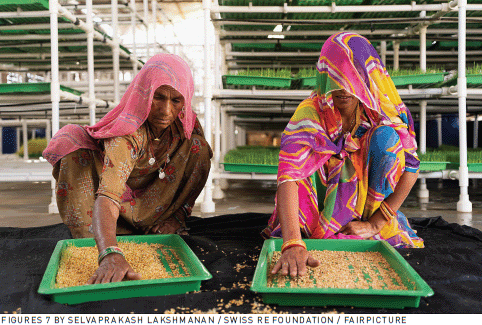 | Figure 7: Two rural Indian farmers preparing sprouted seeds for HydroGreens vertical farming systems inside a microclimate-controlled grow house. |
Supporting small-scale farmers. Farmer suicide is a sad and complex reality in the Indian agricultural sector. Financial insolvency, water scarcity, and adverse weather affecting crops are particularly devastating for small-scale farmers. They may have a small piece of ancestral land or lease a small farm area to grow crops and raise a few animals (typically goats, cows, buffaloes, and chickens). For many small-scale farmers, their farm and livestock are their entire working capital. Our HydroGreens team chose to design for addressing the needs and vulnerabilities of small-scale farmers who do not have many resources. They might not have extra farmable land to grow fresh fodder for livestock or money for setting up expensive technological infrastructures or access to enough water and soil nutrients in extreme-weather-prone geographical terrains.
We designed vertical-growth fodder stations that can reliably produce high-quality fresh fodder for livestock using less water in arid regions. After three years of deploying and iteratively developing these systems in eight Indian states with extreme climate situations, we have found that our vertical farming system provides a predictable and reliable crop yield comparable to ground yield. Having access to fresh, high-quality fodder in arid regions provides consistent nutrition for livestock, which improves their overall health and is shown to increase milk yield from cows. In this way, HydroGreens systems contribute toward supporting small-scale farmers in India (Figure 8).
 | Figure 8: A rural Indian farmer collecting fresh fodder from a HydroGreens vertical farming trough. |
Including rural women. The compost used in HydroGreens vertical farming systems is purchased from rural women's self-help groups (Figure 9). This decision is a conscious effort to integrate rural women as active agents in the inclusive transformation of CSA in India. Engaging with issues faced by disenfranchised and exploited women from diverse socioeconomic groups through the Mahila Kisan Adhikar Manch (MAKAAM, the Forum for Women Farmers' Rights), Seema Kulkarni emphasizes: "Ecological health and the contributions of women's unpaid care work towards it will thus have to be framed in a manner that addresses upfront the question of women's ownership and control over resources" [2]. Purchasing compost from rural women's self-help groups institutionalizes a circular economy and helps foster a sense of community. Our systems implement an inclusive business model by buying compost from rural women, since these women often are skilled at and do the labor related to composting in an ecologically responsible manner. Some rural women farmers in arid regions are users of HydroGreens systems and benefit from having a reliable source of income through their livestock. In this way, HydroGreens systems help create gainful opportunities for rural women.
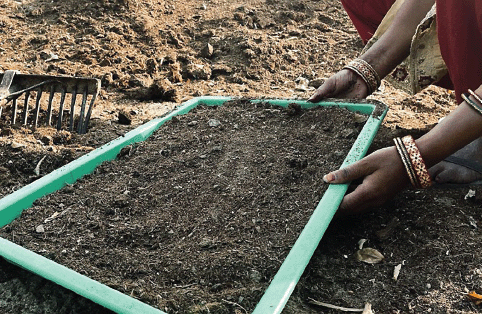 | Figure 9: A rural Indian woman preparing compost that will be sold through women's self-help groups. |
Conserving water in arid regions. Water-related disasters in India have become more common and unpredictable in recent years. These may be slow, long-term climate change—related effects such as desertification or sudden, short-term extreme events such as floods. Water scarcity can trigger disastrous cascading effects on agriculture, health, livelihoods, and the biodiversity of local ecologies. Water-efficient agricultural practices are required to ensure food security and help farmers innovatively adapt to India's climate change impacts. In many ways, climate extremes such as floods or wildfires gain more public attention and State support because disaster responses to such events are more tractable and immediate. In comparison, "slow burning" climate effects such as water scarcity and deforestation are often less visible and can become more backgrounded. This means tackling water scarcity in India requires more community efforts in arid regions when rains fail. The cocoponics troughs used in HydroGreens vertical farming systems that are set up inside microclimate-controlled grow houses utilize the recirculated water used to wash solar panels. This makes it possible to avoid water wastage in the already water-scarce desert regions.
Offering an alternative to soil farming. Broadly speaking, India has seven basic types of soil. The country is broadly divided into 15 agricultural regions based on agroclimatic features such as soil type, and climatic indicators like temperature, rainfall variation, and water scarcity. Climate change—related impacts on soil are a complex, ongoing phenomenon with physical indicators (soil erosion, deforestation, etc.), chemical indicators (low soil nutrition, acid/alkaline levels, etc.), and biodiversity indicators (health and composition of soil microorganisms, etc.). The complex relations between soil and climate change go beyond agriculture and are not yet fully well understood. What we do know based on existing research is that improving soil health and exploring alternative ways of sustainably growing food are major priorities for achieving food security through CSA technologies and practices. Thus, efforts to improve soil health must be accompanied by complementary explorations for alternatives to soil farming where necessary. Combining cocopeat and compost provides a healthy substrate for growing a variety of crops using less water with our HydroGreens systems. The combination of cocopeat and compost can retain hydration longer in arid regions, which can lead to maintaining the cooler temperatures in the plant root zone that are necessary for healthy crop growth. Our system design provides a viable alternative to soil farming in arid regions where the soil might be unsuitable for farming (like the soil sample shown in Figure 6).
Enabling climate-smart dairy farming. Farm animals are negatively affected by but also contribute to climate change—related issues. Extreme weather conditions pose severe threats to the health of farm animals, both immediately and long term. For instance, livestock are directly affected by heat stress, which leads to animal mortality and decreases in productivity, and indirectly affected by water scarcity, which causes a shortage of fresh fodder and a higher risk of diseases due to poor sanitation. At the same time, raising farm animals contributes to anthropogenic greenhouse gas (GHG) emissions, primarily nitrous oxide (N2O), methane (CH4) and carbon dioxide (CO2). For dairy farmers in India, consistent access to better-quality fodder for their animals is of utmost importance to efficiently provide good nourishment for livestock, which improves animal health and milk yield and significantly lowers the level of GHG emissions from enteric fermentation and manure. Enteric fermentation occurs in the digestive tract of ruminant animals such as cows, goats, and buffaloes, producing methane as a by-product from microbes decomposing and fermenting what the animal consumes.
Working toward climate-smart dairy farming requires recognition of the link between GHG emissions and the efficiency with which farmers can utilize limited available resources.
Working toward climate-smart dairy farming requires recognition of the link between GHG emissions and the efficiency with which farmers can utilize limited available resources. The National Dairy Development Board (NDDB) in India notes that "animals fed balanced rations, comprising a judicious mix of green fodder, dry fodder, and concentrate feed ingredients, had a 14 percent lower water footprint of milk (1236 vs. 1062 litre/kg)" and "therefore feeding systems that integrate the usage of crop residues and agricultural byproducts have lower water footprints and are more environment friendly" [3]. Here, water footprint of milk is defined as "the sum of the volume of freshwater consumed in different steps of milk production chain, measured in units of water consumed (litre) per kg of milk" [3]. Our HydroGreens vertical farming systems provide a viable, low-cost option for small-scale dairy farmers living in arid regions with water scarcity to consistently grow fresh, good-quality fodder for their animals. Farmers who have used our HydroGreens vertical farming systems have reported noticeable improvements in animal health and milk yield.
How I got information about the soil. To boost the nutrition of the cocopeat substrate, we use composts that come from different self-help groups. These composts vary in nutritional composition and need to be standardized and customized for each grown crop. We use handheld devices in combination with soil-analysis lab reports to understand the compost's nutrient profile. We have been training our grassroots employees how to conduct basic tests of soil health, including measuring acidity using a basic pen-type pH meter as well as measuring total dissolved solids (TDS) and electrical conductivity (EC). As our scale grows, we will deploy handheld spectral devices to analyze the substrate composition.
In this dialogue, we have discussed how the multiple complexities of soil health could be understood and sensed—and how digital technology can support farming communities. The discussion has been underpinned by feminist perspectives in which soil has been used as both a metaphor and a concrete case to address feminist concerns in technoscience [2,4]. By caring for the soil, we increase its capacity to care for us in a process of mutual interdependence. Parvati Raghuram explores the geohistories of care, introducing the notion of emplacement to uncover the "structural conditions of caring (which are place sensitive) and the uneven geographies of colonial and postcolonial development" [5]. Thus, caring for a living soil entails the emplacement of care ethics: "Instead of applying care ethics to different places we could ask what difference it makes to the ethics of care if we start from care as practiced differently in different places" [5].
The two cases, from Sweden and India, show that we can reimagine and renourish soil as consisting of new compositions, be it collectively sourced bokashi compost or compost purchased from rural women's self-help groups. In Anton's work, the example of conducting soil chromatography in a collectively managed urban farm in Sweden points to the relational and caring practices that emerge when we begin to deeply understand and connect with our soils. In Vasanth's work, using a cocopeat-compost mixture shows a pragmatic way of improving the livelihoods of rural women and small-scale farmers in arid regions in India. The two cases juxtaposed here demonstrate the diverse multicultural nature of care practices. Raghuram argues that since "care is relational and enacted across space, the differences in care ethics between places have to be negotiated" [5]. Therefore, we want to emphasize the need for critical awareness about the geopolitical realities of climate change while theorizing about an ethics of care.
These two cases demonstrate that by knowing the soil better, we can care for it better by providing what is necessary for its health, welfare, maintenance, and protection. Knowledge and care thus seem foundationally entangled and geopolitically situated. In this way, the process of knowing the soil, of touching and being close to it, is an act of care that involves multiple stakeholders enmeshed in unequal power relations with diverse values and priorities. Seema Arora-Jonsson's insightful analysis about the discourses on women, gender, and climate change using examples from Sweden and India notes: "By reiterating statements about poor women in the South and the pro-environmental women of the North, these assumptions reinforce North-South biases" [6]. Feminist researchers in HCI have emphasized that "critical engagement with intersecting axes of injustices without reducing and freezing people as victims is a complex challenge that warrants thoughtful and creative responses" [7]. As Arora-Jonsson writes, "Generalizations about women's vulnerability and virtuousness can lead to an increase in women's responsibility without corresponding rewards" [6]. We thus need to design climate-smart agricultural technologies that are attendant to the gendered geopolitics of climate change and an emplaced ethics of care.
Our dialogue about soil indicates an immediate need to enable the sharing of situated knowledge and data about soil care. There is an urgent and important need for shared, comparative, emplaced, and interconnected understandings about soil. To practice an emplaced ethics of care, we also need to share the stories of why certain soils are meaningful to us, connecting us back to the land. To support such sharing, Anton has initiated a crowdsourced library, where people from around the globe can upload images of their soil chromatographs and share their interpretations and stories of why the sample matters to them. You can contribute to the library at https://poiros.com/Soil-chromatography.
1. Rosén, A.P. Relating to soil: Chromatography as a tool for environmental engagement. Proc. of Designing Interactive Systems Conference. ACM, New York, 2022, 1640–1653; https://doi.org/10.1145/3532106.3533503
2. Barca, S. et al. Caring communities for radical change: What can feminist political ecology bring to degrowth? In Contours of Feminist Political Ecology. W. Harcourt, A. Agostino, R. Elmhirst, M. Gómez, and P. Kotsila, eds, 2023; https://doi.org/10.1007/978-3-031-20928-4_8
3. National Dairy Development Board. Water footprint of milk; https://www.nddb.coop/services/animalnutrition/climate-smart-dairying/water-footprint-of-milk
4. de la Bellacasa, M.P. Making time for soil: Technoscientific futurity and the pace of care. Social Studies of Science 45, 5 (Oct. 2015), 691–716; https://doi.org/10.1177/0306312715599851
5. Raghuram, P. Locating care ethics beyond the Global North. ACME: An International Journal for Critical Geographies 15, 3 (2016), 511–533; https://acme-journal.org/index.php/acme/article/view/1353
6. Arora-Jonsson, S. Virtue and vulnerability: Discourses on women, gender and climate change. Global Environmental Change Volume 21, 2 (2011), 744–751; https://doi.org/10.1016/j.gloenvcha.2011.01.005
7. Juul Søndergaard, M.L. et al. Feminist voices about ecological issues in HCI. Extended Abstracts of the 2022 CHI Conference on Human Factors in Computing. ACM, New York, 2022, Article 90, 1–7; https://doi.org/10.1145/3491101.3503717
Anton Poikolainen Rosén is a postdoctoral researcher in human-computer interaction at Aalto University in Helsinki, Finland, where he works with more-than-human design and the problem of how to evaluate future-oriented prototypes. His Ph.D. focused on how urban permaculture communities in Stockholm, Sweden use information technologies to notice and care for their gardens. [email protected]
Vasanth Madhav Kamath is an entrepreneur from India. He is the founder of HydroGreens Agri Solutions (hydrogreenfodder.com), a pioneer in fresh livestock feed, and is working toward developing a business model for growing carbon-negative fodder in low-cost, microclimate-controlled grow houses. He works with people living in extreme climates and arid desert zones, where the topsoil cannot support reliable farming and therefore requires alternative ways of producing feed for livestock. [email protected]
Gopinaath Kannabiran is an HCI researcher, design educator, sexual rights activist, and yoga instructor. He is an assistant professor in the School of Information at Pratt Institute in Brooklyn, New York. [email protected]
Copyright held by authors. Publication rights licensed to ACM.
The Digital Library is published by the Association for Computing Machinery. Copyright © 2023 ACM, Inc.








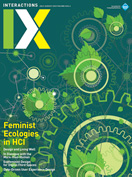
Post Comment
No Comments Found